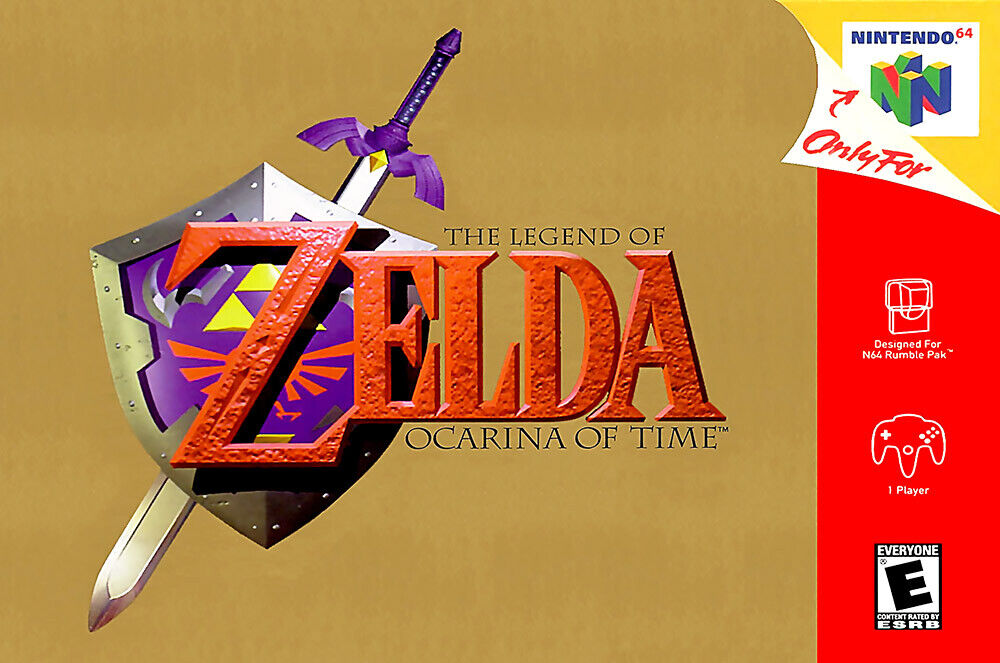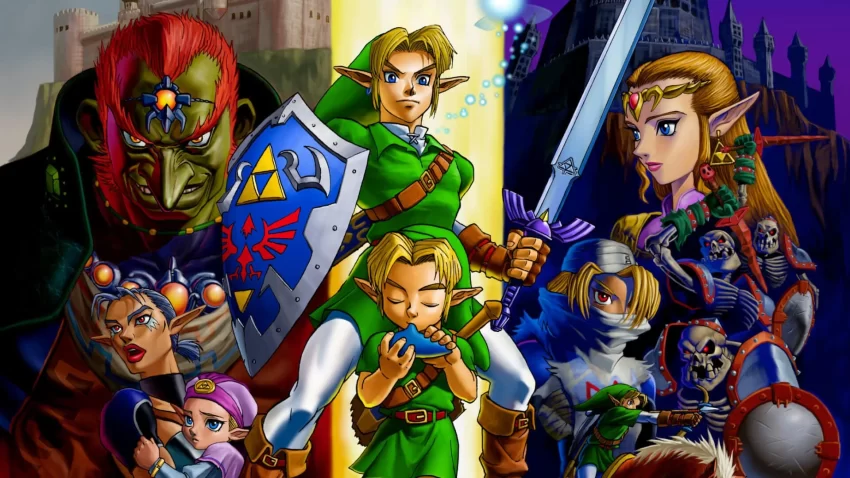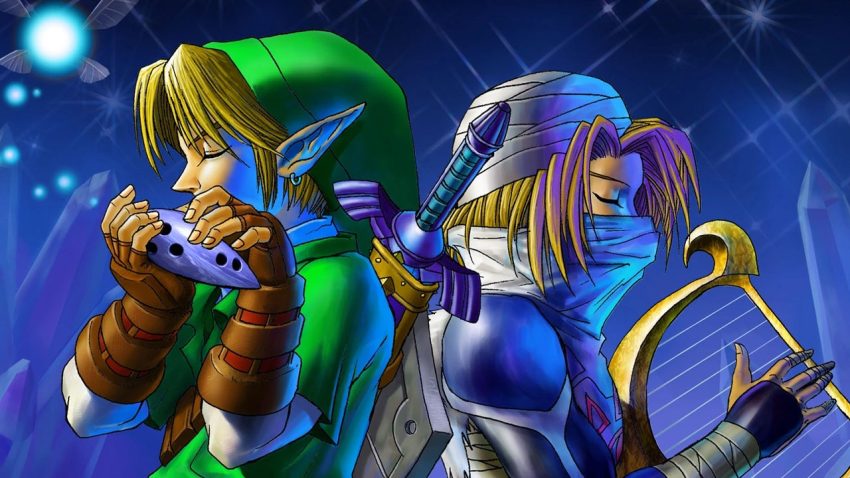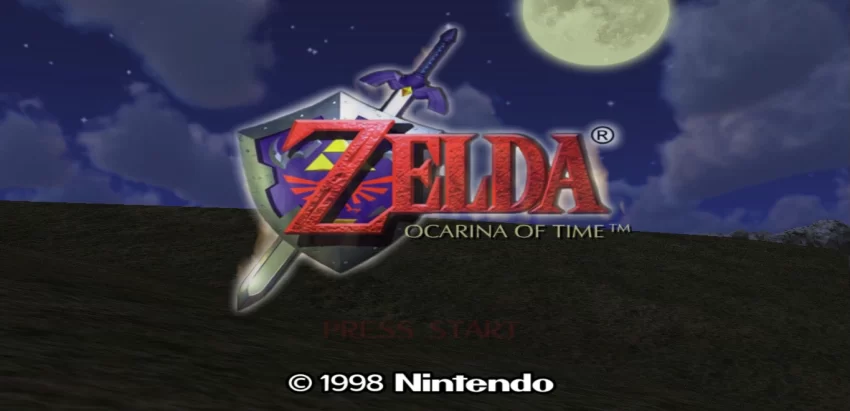Twenty-Five Years Later, Ocarina of Time Is Still An Astounding Accomplishment That Looms Large In Video Game History
Posted on November 23 2023 by Sean Gadus

When observing the video game industry, it often feels like the relentless advance of technology can cause innovative games from past generations to be swept away quicker than their counterparts in film, television, or books. At times, it can feel tragic the way critically acclaimed and beloved games are brushed aside or rendered obsolete when shiny, new consoles are released. Additionally, as gaming technology marches forward, comparing different current-generation games with past games can lead to unfair complaints that last-gen games are ugly or unimpressive. For fans enjoying cutting-edge games and impressive new systems, looking back at previous generations of video games can feel like an unnecessary endeavor.
Fortunately for video game fans, The Legend of Zelda is among the most rewarding series to revisit, whether you are using the original hardware or playing remakes. Because of the brilliant design ideas and incredible care that Nintendo has put into the series, each Zelda game has something worth revisiting or something worth experiencing for the first time.
Among Zelda games, Ocarina of Time remains one of the most enjoyable and important games to revisit. In 1998, when the first 3D Zelda game was released, there was nothing on the market quite like it. Ocarina of Time was a stunning experience that helped define how action-adventure games worked in 3D, and many modern games still lovingly draw influence from the mechanics and systems that Ocarina of Time helped implement and pioneer.
So, on the twenty-fifth anniversary of the game’s release in North America, it is a great time to reflect on why so many fans, critics, and developers still feel like Ocarina of Time is among the most important games in video game history.
Countless Innovations That Set The Precedent for A Genre and A Generation

The influence of Ocarina of Time on video games is wide ranging; but to better understand the massive impact of the 1998 game, it is important to look at its specific innovations and how it changed the action-adventure landscape.
One of the features that the game industry has taken from Ocarina of Time is its camera system. The brilliant Z-Targeting system has helped define how action-adventure games function. When approaching an enemy or point of interest, the player can press the Nintendo 64’s Z-button to immediately focus on that object. Most modern action and adventure games use some type of automated camera system or targeting system that can trace its roots back to the Z-Targeting system that Nintendo implemented in Ocarina of Time. It is remarkable that the Z-targeting system works so smoothly considering that Ocarina of Time was Nintendo’s first 3D Zelda game. While the targeting system would be further refined in an assortment of future action-adventure games, it is impressive how effective the system was in 1998.
In addition to the Z-Targeting system, Nintendo had a number of other impressive design concepts that would inform future games. While context-specific buttons have been around since the beginning of video games, Nintendo’s implementation of the context-specific controls with the A button is brilliant. This all-in-one button can be used for everything from speaking to NPCs, rolling, picking up rocks or Bomb Flowers, and a variety of other functions. Nintendo even displayed the actions of the A-button on Ocarina of Time‘s HUD to make it easier for players to use the button.
One of Nintendo’s other great achievements was the implementation of horseback riding. Ocarina of Time nailed the feeling of riding a horse in ways that few other games could match. Many iconic action-adventure games have taken what Ocarina of Time did with Epona and improved the control and design for horses and horseback riding. Even though Epona is not required to complete the game, her importance was cemented when the player saw Link riding Epona on the Ocarina of Time title screen.
Another key innovation in Ocarina of Time was the development of a distinct dungeon and puzzle design in a 3D space. When creating Ocarina of Time, Nintendo had to think carefully about how mechanics would be translated from 2D to 3D and about what new design concepts would be effective in 3D. While Nintendo did carry over the concepts of hitting switches and pushing blocks, it also introduced new mechanics like reflecting light on the Mirror Shield or invisible platforms revealed by the Lens of Truth. Although the Hookshot appeared in A Link to the Past, the transition to 3D made the item even more valuable. The player could now use the tool to move between different floors in a dungeon.
In terms of dungeon design, the controversial Water Temple earned its reputation by implementing a system that let the player change the water level in the temple; this was a design idea that Nintendo would refine in future dungeons. Part of the reason the Water Temple was so challenging to players in the late 1990s was because the temple forced the player to manipulate 3D space in exciting, new ways. You can see the DNA of the Water Temple and the way it forces the player to manipulate 3D spaces in a variety of newer Zelda dungeons, including Breath of the Wild‘s Divine Beasts.
A Time When Music Was Magic

While it is undeniable that future Zelda games have more diverse soundtracks with better instrumentation, the soundtrack of Ocarina of Time is one of the most iconic soundtracks in the history of video games.
Unlike that of most other video games, Ocarina of Time‘s music was not just a part of the background for players to enjoy; music was built into the gameplay and story. The Ocarina mechanic allowed the player to use five different buttons (the four C-Buttons and the A-button) to produce in-game songs. With only five notes available for the Ocarina, Koji Kondo was left with the challenging task of developing a dozen separate melodies from the same five notes. The first six songs (“Zelda’s Lullaby,” “Epona’s Song,” “Saria’s Song,” “Sun’s Song,” “Song of Time,” and “Song of Storms”) all use a three-note structure that is easy for players to remember. In contrast to the repeated structure of the first six songs, the warp songs are distinct in structure and tone. These songs only appear in the second half of the game when the player has grown familiar with the musical mechanic.
Twenty-five years later, the Ocarina mechanic endures as a remarkably effective implementation of music creation in gameplay. This intuitive system weaves together story, gameplay, and sound. While The Wind Waker, Twilight Princess, and Skyward Sword would all attempt their own version of weaving together music and gameplay, these systems never surpassed the Ocarina system created for the Nintendo 64 Zelda games. The connection between music and gameplay also gives the music of the game a special kind of emotional and personal connection with the player. In games like Ocarina of Time and Majora’s Mask, music is a mystical, spiritual force that opens doors to new worlds and makes the sun rise and set.
While Koji Kondo has composed a number of iconic soundtracks for Nintendo, Ocarina of Time‘s is arguably his greatest complete soundtrack. In addition to his brilliant work on the twelve Ocarina songs, Koji Kondo crafted a soundtrack that captured the spirit of adventure and breathed life into the various regions of Hyrule. The game makes brilliant use of adaptive music like the Hyrule Field theme, which changes depending on whether Link is standing still, in combat, or running across the field. Whether it is the cheery Hyrule Castle Town Market theme, the adventurous Gerudo Valley theme, the idyllic title theme, or the haunting Forest Temple theme, Ocarina of Time is full of beautiful songs that draw the player into Link’s grand adventure.
A Remarkable World That Feels More Intimate As Video Games Evolve

While Ocarina of Time‘s world was truly massive in 1998 when the game was first released, it is relatively small by modern gaming standards. The small size of the world in Ocarina of Time (in comparison to future games) has become a surprising part of the game’s appeal rather than a detriment, an unexpected consequence of twenty-five years of rapidly expanding video game maps. In 2023, it feels great having a game world that the player can thoroughly explore in a tidy 25 to 35 hours. The game world has plenty of secrets and mini-games that reward repeat playthroughs, but its relatively small size makes it feel welcoming rather than intimidating or imposing.
While Breath of the Wild and Tears of the Kingdom both boast massive worlds that are more than forty times larger than Ocarina of Time, the points of interest are much further apart compared to its 1998 predecessor. As games continue to grow larger and larger, the amount of points of interest (dungeons, minigames, and secrets) squeezed into Ocarina of Time‘s modestly-sized game world is impressive. With some help from its time travel mechanic and by gating some areas off, Ocarina of Time is able to fit nine dungeons and four mini-dungeons (including the optional Gerudo Training Grounds) in its small world. This is the same number of dungeons as its larger spiritual successor Twilight Princess, which takes place on a larger scale map. Plus, having towns and dungeons relatively close to each other means that there is a excellent balance between exploring, solving puzzles, and battling enemies.
The center piece of Ocarina of Time‘s world is the iconic Hyrule Field. This revolutionary map is cleverly designed to include entrances to most of the major areas of the game, including Kokiri Forest, Lake Hylia, Gerudo Valley, Kakariko Village, The Zora River, and Hyrule Castle Town. Stepping into Hyrule Field in the late 1990s felt like stepping into a vast wilderness. The player can run from one end to the other without a single loading screen, a major accomplishment for the time period.
Hyrule Field also introduces the player to the impressive day and night cycle, which makes the world feel more dynamic and interactive. Many players exploring Hyrule Field for the first time will not reach the Castle Town drawbridge before sundown, forcing them to spend their first night battling or running from Stalchildren. The hub and spoke design of Hyrule Field creates the feeling that the areas of Ocarina of Time are all intricately connected; the different locations branch off from the centrally located Hyrule Field. This effective system makes the world easy to navigate, and the ability to enter certain towns and areas before they had any relevance to the main quest was an early example of Nintendo’s willingness to let players get lost in its game worlds.
A Beautiful Yet Tragic Story That Continues To Spur Reflection

Ocarina of Time has a simple story, but it tells its story very effectively. While the open-air Zelda games have struggled to tell a story while laboring under the weight of their gameplay systems and world design, Ocarina of Time‘s semi-linear structure leaves room to tell a simple yet satisfying story. With relatively few cutscenes or flourishes, the team behind Ocarina of Time was able to create an enjoyable and surprisingly bittersweet adventure that has aged well.
Ocarina of Time has arguably the greatest and most impactful “mid-point” event in the Zelda series. While many of the Zelda games since A Link to the Past feature a key event that shifts the story after the player has completed an initial set of dungeons (Zant’s attack on Midna in Twilight Princess, entering Hyrule in The Wind Waker, Zelda going back in time in Skyward Sword), Link drawing the Master Sword in Ocarina of Time is a stunning event that helps cement the game’s iconic status in video game history. With this stunning twist, Link and Zelda do not dabble in defeat; they are utterly defeated by Ganondorf. After awakening in the Chamber of Sages after seven years of slumber, Link emerges into a world devastated by an evil he inadvertently helped create. Making the first trip into the desolate Castle Town is a sobering experience that immediately raises the stakes of Link’s quest.
Time is central to Ocarina of Time, both mechanically and narratively. While Majora’s Mask implements a more radical time mechanic, Ocarina of Time‘s use of time is still extremely effective. Majora’s Mask embraces a sense of pressure and overwhelming dread as the clock ticks toward doomsday, but the bittersweet nature of time in Ocarina of Time is more subtle. The most effective mouthpiece person for the tragedy of time lurking at center of Ocarina of Time is Sheik, whose speeches at each temple reflect on the nature of time.
Sheik’s dialogue at the Sacred Forest Meadow is one of the most striking quotes from the game:
The flow of time is always cruel.
Its speeds seems different for each person, but no one can change it.
A thing that doesn’t change with time is a memory of younger days.
While the game allows Link a chance to go back to younger days, the player cannot. When we are young, we may not think about how fast we move from one stage of our life to the next, how friends come and go through the years, how the distance between who we were and who we are can shrink or grow. Ocarina of Time reflects on the beautiful and bittersweet nature of time with Sheik’s poetic reflections and by making the player explore the world through the eyes of a child and an adult.
Conclusion

For players across a variety of generations, Ocarina of Time is not just a great game; it is a lightning bolt, a once-in-a-lifetime event that changed the way they see video games. In 2023, it can be lost on newer players how innovative Ocarina of Time is because of how much the industry drew inspiration from the game. Pick up any number of modern action-adventure games, and you will be able to see design concepts and game systems that Ocarina of Time helped pioneer in the late 1990s.
Even without discussing the innovative nature of Ocarina of Time, the game is still incredibly easy to pick up and play today. While each subsequent 3D Zelda game added mechanics to the original formula established in A Link to the Past and Ocarina of Time, the 1998 game feels remarkably unburdened by unnecessary mechanics and padded-out questlines. The core mechanics of exploring a vivid world, solving clever puzzles, battling ferocious enemies, and slaying mighty bosses all work together in exquisite harmony. Even with its muddy, outdated graphics, the core design skeleton of Ocarina of Time remains remarkably effective to this day.
In November 1998, players took a young boy and his fairy out of their comfortable forest home. They set out on a grand journey full of joy, wonder, danger, fear, melancholy, and hope. Twenty-five years later, Ocarina of Time still holds a special place in the hearts of millions of players because of its wonderful world, its evocative music, its thrilling enemies, and its heartfelt story. What greater legacy could a game leave?
What are your memories of Ocarina of Time? How do you feel about the game on its twenty-fifth anniversary? Let us know your thoughts in the comments below!

Sean Gadus is a Senior Editor at Zelda Dungeon. His first Zelda game was Ocarina of Time, and he loves all of the 3D Zelda games from 1998-2011. The final battle of Tears of the Kingdom is one of his favorite final battles in the entire series. He wants to help build a kinder, more compassionate world. You can check out his other written work at The-Artifice.com.



